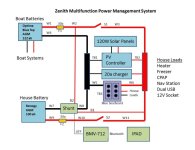I have over 40 years running chest type/under counter type and built in condenser, with really good insulation off 12 volts.
You have to know what your battery capacity is, and monitor it. Where you boat will determine what the refrigerator draw will be. A good rule of thumb is 60 amp hours for a single chest type refrigerator. The front opening will take a little more current, since the insulation is often not quite as good, and the number of times you open the door will also determine how much run time you will have. A refrigerator at Lake Powell, with ambient will be close to 100* during the day, will take a lot more current than a refrigerator in Maine, where the ambient is 60* during the summer. The water temperature will also be a factor.
You have group 24 batteries, and they are the minimum size for your boat and engine. They are probably of the "combination, start and "deep Cycle" which are not really deep cycle (Deep cycle will be heavier because they contain more lead.).
Many C Dorys come with Interstate dual purpose batteries so I will use them as a point of reference.
Group 24 Dual purpose has to 64 amp hours available--or 32 amp hours usable if you don't discharge more than 50% (This is a resting steady state voltage of 12.2 volts--no charging or current draw for 2 hours.)
The Group 31 Dual purpose had 100 amp hours available or 50 usable.
If you jump to Interstate's "Deep Cycle" line it is not all that much different!:
Group 24: 81 amp hours
Group 27: 88 amp hours
Group 31: 98 amp hours.
Other brands may vary slightly--up to 110 Amp hours for a group 31. The lower the current draw the more capacity...So drawing the 5 amps which is with the motor running, the standard 20 hour rating works well.
Also you have to consider the type of battery: If you are keeping the battery out of doors, then the Flooded lead acid works fine. But if you put inside the cabin they can vent hydrogen gas when charging, there is potential of both toxicity and explosion/fire. So if you want to put the battery inside the cabin--you want to go with AGM. The AGM are more expensive, should last longer and will often have a bit more capacity
You have an excellent battery charger. It is a "smart charger, and it can be profiled for various scenarios and a variety of different lead acid battery types.
For my 22's I have always gone over to 3 group 31's--and that has done well for a chest or front loading refrigerator. With the current C Dory 25, I wanted to experiment with the LiFePO4 batteries, and with two group 31, 100 amp hour batteries, I have usable 180 amp hour capacity. I can rapidly charge these batteries at 80 amps per hour--at least at the start of the charging profile--the LI batteries charge far faster. They are lighter,, resting state is 13.2 volts and maintain over 12.2 volts until 85% discharged and can be put in the cabin on almost any position (such as on the side). BUT they are expensive, need specific chargers, including a battery to battery charger from the outboard, as well as a specific profile 110 mains charger.
The flooded lead acid battery has a limited capacity to accept a charge, and will take longer to charge--ie a lower charging rate, than the AGM and LI lion type of batteries.
AGM are oK inside the cabin, they can be mounted anyway but upside down, they will charge up to 5x faster than the flooded lead acid battery. Although this is somewhat debated, a quality AGM battery will survive better after deeper discharge. With the usual recreational boater 70 or so % discharge will shorten the life, but unless you are doing this daily, it is probably not going to be significant in affecting the life span of the battery.
For your application I would go to 3 group 31 batteries. Put in a "Combiner"--Automatic charge relay or voltage sensitive realay (same thing), between the start and house bank. (The house being two group 31's in parallel. Start with new batteries of the same type and capacity. The self discharge of the AGM is minimal, They do not need electrolyte added.
As for the charger, I would put a charging lead to each battery, considering the specific charger which you have. You will not get more than 20 amps out of it total, but it will proportion if there is one battery lower than the others.
I also would put in a Victron 702 or 712--this monitors the voltage, amps used-amps in and state of charge. The 712 has more perimeters and can be read on an I phone.


